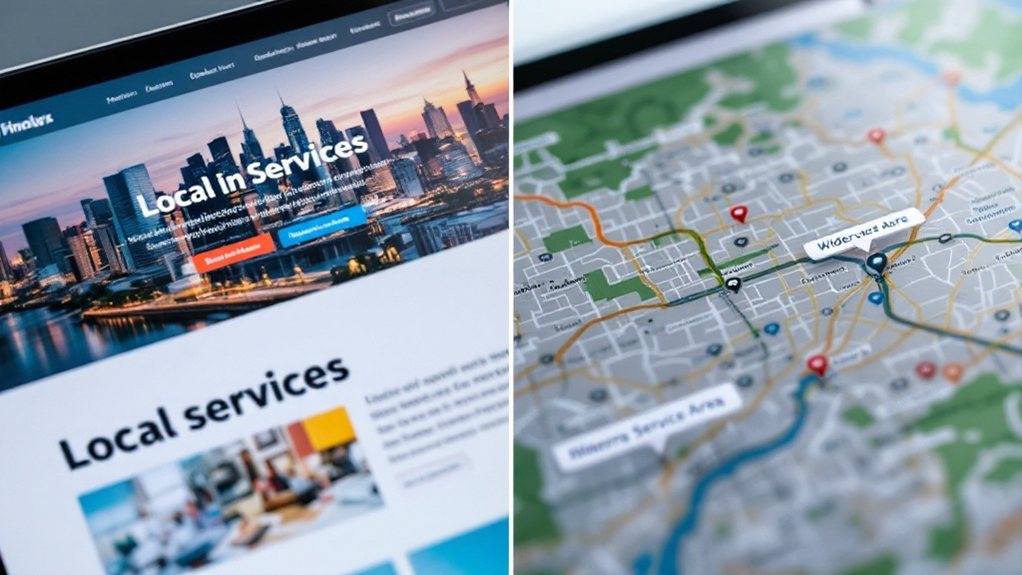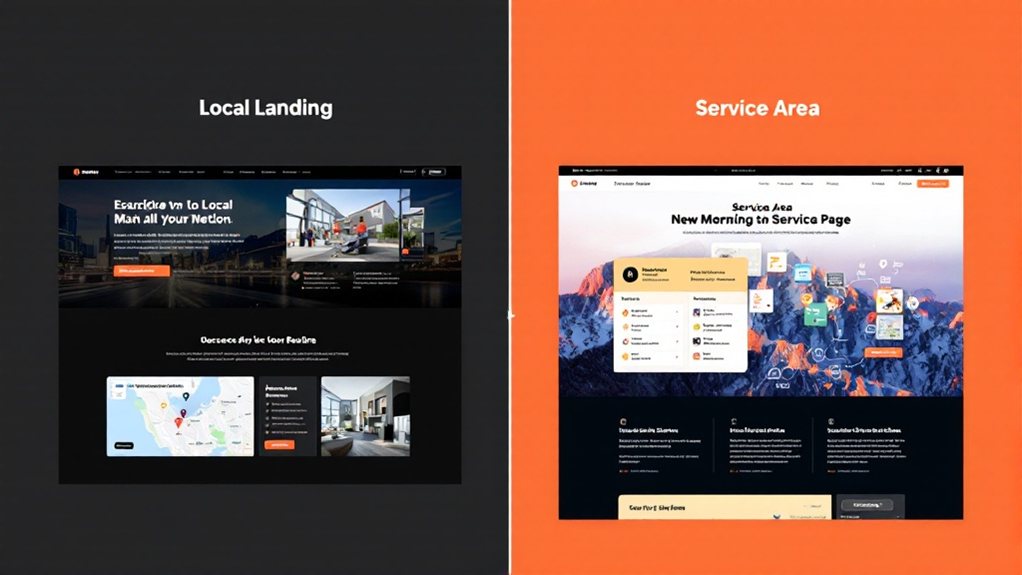Local landing pages and service area pages serve different purposes in your local SEO strategy. Local landing pages optimize for physical business locations, while service area pages target businesses without storefronts. Both can improve visibility, trust, and conversions, but you'll need to carefully design and structure them based on your business model. To optimize your local search performance and provide a great user experience, you'll want to understand the unique considerations for each approach.
Purpose and Functionality

The purpose of local landing pages is multi-faceted. They enhance your business's visibility in local search results by targeting specific geographic keywords. These pages build trust and relevance by showcasing local information, community involvement, and service specifics. The tailored content and calls-to-action lead to higher conversion rates among local visitors. They also provide users with location-specific details, improving their experience. By focusing on local content, you can outperform competitors in the local market. Local landing pages are also crucial for businesses that operate in a specific geographic area and want to attract local customers.
Service area pages are used for businesses that serve multiple locations without physical premises. They help you rank for searches in various service areas without claiming false physical locations. The pages clearly outline your service areas, serving as part of a broader local SEO strategy.
Design and Structure

Designing and structuring effective local landing pages and service area pages requires a thoughtful approach. Ensure the most visible elements above the fold clearly communicate your unique selling proposition and call-to-action. Optimize for mobile responsiveness, incorporate high-quality visuals, and add interactive elements like videos or 360° tours. Build credibility through testimonials, reviews, and certifications. Highlighting local collaborations can also help showcase your business's commitment to the community.
| Design Principles | Content Strategy | User Experience |
|---|---|---|
| Elements Above the Fold | Localized Content | Maps and Directions |
| Responsive Design | Keyword Optimization | Conversion-Focused CTAs |
| Visual Content | Image Optimization | Social Proof Display |
Streamline the information architecture with a logical URL structure, consistent NAP, and structured data to enhance local SEO. Leverage visuals like photography, videos, and graphics to engage users and showcase your services.
SEO and Ranking

Effective local SEO is crucial for boosting your online visibility and driving qualified traffic to your landing pages. Optimizing your Google Business Profile's primary category, proximity, and keywords is vital for ranking in local pack results. Building high-quality backlinks further enhances your local organic rankings. Ensuring your Google Business Profile is complete and verified also improves trust and visibility. On your landing pages, using geographic keywords, strategically linking content, and maintaining a mobile-friendly design are key. 92% of local SEO and marketing professionals claim to have experimented with ChatGPT. For service area pages, focus on major cities, provide transparent service area details, and avoid doorway pages. With these SEO best practices, you can improve your local search performance and convert more customers.
User Experience
As a business owner, your local landing pages and service area pages play a crucial role in shaping the user experience. Users expect relevant, organized, and localized content that enhances conversion rates. Incorporating location-specific details, clear calls-to-action, and interactive elements can improve engagement. Ensure a seamless user flow by integrating service area pages into your main navigation and providing clear definitions of your geographic scope. Websites with at least 41 landing pages are able to generate over 500 leads, which highlights the importance of having a sufficient number of landing pages to drive user engagement and conversions.
| User Expectations | User Engagement | User Flow |
|---|---|---|
| Content Relevance | Testimonials and Reviews | Main Navigation Integration |
| Information Organization | Clear CTAs | Clear Service Area Definition |
| Conversion Rates | Interactive Content | Organizational Clarity |
| Location Specificity | Page Length and Content Quality | Avoiding Confusion |
| Navigation Accessibility | Page Design | Seamless User Experience |
Creation and Maintenance
To create and maintain effective local landing pages and service area pages, start by clearly defining your goals. This will help guide your content strategy, SEO efforts, and overall resource allocation.
Next, focus on unique, location-specific content that avoids duplication. Highlight:
- Local testimonials
- Community partnerships
- Relevant events
Analyzing the target market can further help identify the most effective level of location detail to include on these pages.
Finally, regularly audit your pages to ensure:
- Consistent NAP information
- Fresh, up-to-date content
- Optimal technical performance
Benefits and Challenges
While local landing pages and service area pages both offer benefits, they also come with their own set of challenges. Local landing pages optimize for specific keywords, improve local SEO, and generate more leads, but developing unique content and maintaining consistency is resource-intensive. Enhancing local search rankings and increasing customer visits are key benefits of effective local landing pages. Service area pages simplify navigation and reduce duplication, yet they lack the specificity of local pages and may not capture local search intent as effectively. Both approaches require careful keyword research, user-centric design, and consistent branding. Businesses must balance the benefits and challenges of each approach to determine the most suitable strategy for their unique needs and target audience.
Distinguishing Local Landing Pages
Local landing pages are designed to attract and convert visitors from a specific geographic region. They focus on providing location-specific information to enhance local search visibility and engagement. Crafting effective local landing pages requires customizing the content, contact details, and other key elements to cater to your target audience's needs. Dedicated landing pages are important for SEO and generating leads, and creating good local landing pages is considered best practice by local search marketers.
Defining Local Landing Pages
When defining local landing pages, it's important to distinguish them from their counterparts, service area pages. Local landing pages are tailored to specific geographic regions, featuring localized content, contact information, maps, social proof, and clear calls-to-action. This purpose-driven approach enhances SEO, conversion rates, user experience, trust, and PPC optimization. Service area pages, on the other hand, are regional-focused and SEO-optimized for broader geographic searches.
Three key benefits of local landing pages include:
- Targeted marketing to specific audiences
- Increased relevance and community connection
- Improved local visibility and scalability
The creation and optimization of these pages involve a content strategy, user feedback, analytics integration, and SEO audits, ensuring they integrate seamlessly within the website structure.
Geographic Targeting Focus
Though local landing pages and service area pages may appear similar, it's crucial to distinguish their differences. Geographic targeting is the heart of local landing pages, allowing businesses to tailor content and marketing efforts to specific locations. This involves optimizing for local search factors like consistent NAP, Google Business Profile, and customer reviews. In contrast, service area pages focus on highlighting the geographic regions a business serves, without necessarily providing location-specific content. Effective geographic targeting is key for local landing pages, enhancing visibility, relevance, and trust with local audiences. Understanding this distinction is vital for businesses seeking to maximize their local online presence.
Content Customization Importance
Customizing content is paramount when distinguishing local landing pages from their counterparts. Tailoring informational content to highlight your community engagement, showcase local testimonials, and offer enticing location-specific promotions resonates powerfully with your target audience. Moreover, optimizing the user experience through intuitive navigation, readily available contact details, and responsive design ensures visitors remain engaged and convert. Additionally, incorporating a clear call-to-action can guide users towards the desired conversion goal. Ultimately, local landing pages that seamlessly blend relevant content, an exceptional user journey, and strategic search engine optimization emerge victorious in the battle for visibility and qualified traffic.
Optimizing Service Area Pages
Optimizing service area pages requires a strategic approach to geographic targeting. Leverage content optimization techniques like incorporating local information, statistics, and a compelling call to action. Ensure technical best practices, such as clear URLs and schema markup, to enhance discoverability and user experience.
Geographic Targeting Strategies
When it comes to optimizing your service area pages, geographic targeting strategies play a crucial role in boosting your local visibility and attracting the right customers. By incorporating location-specific keywords in your URLs, tailoring content to local needs, and clearly displaying your service areas, you can enhance your relevance and improve your rankings in local search results.
To further strengthen your local SEO strategy, consider these approaches:
- Leverage unique location content to personalize your pages.
- Research local insights to understand your target audience better.
- Incorporate localized keywords and cultural references to engage your local community.
Strategically using maps and optimizing for mobile devices can also elevate the user experience, driving more qualified leads and conversions.
Content Optimization Techniques
To further strengthen your local SEO strategy, you'll want to focus on content optimization techniques for your service area pages. Implement a clear URL structure, optimize page titles and meta descriptions, and provide location-specific content. Incorporate local landmarks, community elements, and employee information to establish relevance. Ensure your pages are technically sound, with an XML sitemap, internal linking, and mobile optimization. Offer unique, valuable content with case studies, first-party data, and transparent pricing. Finally, monitor your performance through local search rankings, traffic analysis, and conversion metrics.
| Clear URL Structure | Page Titles & Meta Descriptions | Location-Specific Content |
|---|---|---|
| Example.com/services/plumbing/sacramento | Incorporate services and locations | Detailed local information |
| Compelling calls to action | Local testimonials, regional challenges | |
| Local Landmarks & Community | Employee Information & Local Involvement | XML Sitemap Inclusion |
| References to local areas | Employees' connections to the area | Facilitate indexing |
| Community events | Local sponsorships |
Integrating Local and Regional Strategies
Integrating local and regional strategies requires a thoughtful approach. By aligning your local landing and service area pages, you can achieve a consistent online presence and effectively reach diverse audiences.
Consider these key factors:
- Achieve Geo-Targeting: Use both types of pages to improve visibility in searches for specific locations or broader regions.
- Balance Content: Blend local-focused and regionally-targeted content to cater to the needs of your audience.
- Analyze Performance: Utilize tools like UTM parameters to track the success of each page across different geographic areas.
Combining these strategies will help you optimize for local and regional visibility, ultimately driving more qualified leads and customers to your business.
Measuring and Improving Performance
Measuring and tracking the performance of your local landing and service area pages is crucial for driving continuous improvement. Pay close attention to key metrics like page views, bounce rate, conversion rate, average time on page, and impressions. A high bounce rate or low conversion rate signals areas needing optimization. Optimize page load times, craft clear messaging, and create engaging content to boost user engagement. Leverage local SEO techniques and mobile optimization to enhance relevance and accessibility. Regularly A/B test calls-to-action and streamline conversion processes. Combine Google Analytics and Search Console data to pinpoint opportunities and track progress over time. Consistently reviewing performance and incorporating user feedback will help you refine your local landing page strategies.
